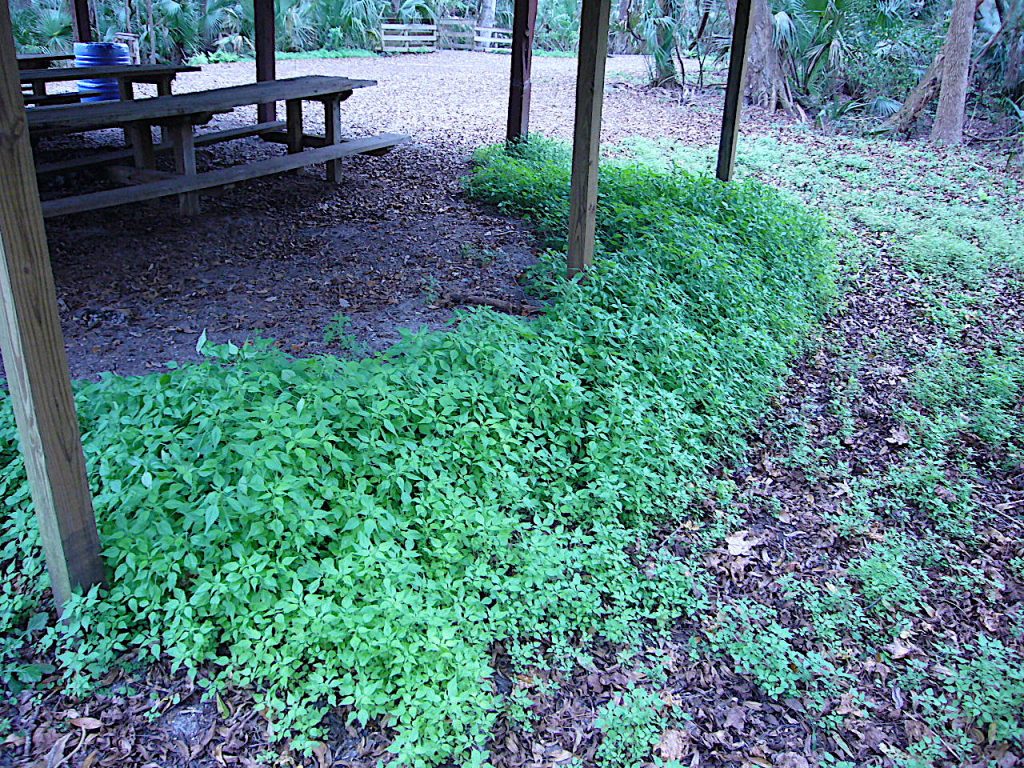
Pellitory likes cool weather and shade. Photo by Green Deane
During our foraging class in West Palm Beach Sunday we saw inch-high sprouts of the winter edible Pellitory. This shade-loving perennial shows up when fall weather starts and stays around until at least mid-spring. Some years in very shady places you can find old straggling specimens as late as July. It smells and tastes like cucumber thus is also called Cucumber Weed. It’s not a plant you find in the middle of a sunny field. Look for it in shady places like under bridges and big trees To read more about this winter comestible go here.
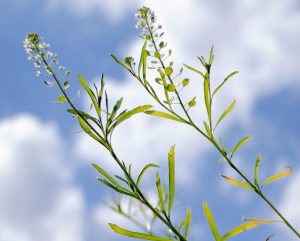
Seeding Poor Man’s Peppergrass. Photo by Green Deane
We also saw a plant that is here all year but strongy favors the wintertime: Poor Man’s Peppergrass. This Wasabi taste-alike definitely favors the cooler months and can be found everywhere locally. The most difficult thing about Peppergrass is that it always looks different in warmer climates. In northern areas it’s a two-year plant and is either a basal rosette of leaves or a seeding flower spike. Because seasons are amorphous locally it can be in any stage any time. So you might find it low with big, wide leaves, or tall with skinny leaves. You just have to learn to recognize it in all of its growth stages. One constant theme is that is always tastes the same though younger plants tend to have a stronger flavor than older plants. To read more about Peppergrass click here.

Classes are held rain or shine.
We might have to dodge tropical weather for a couple of weeks more so the weekend after next than this weekend. Saturday’s class is in Port Charlotte. It’s aways a nice stroll along the Peace River. Sunday’s class in Mead Gardens near Orlando. It has a lot of diversity.
Saturday, November 7th, Bayshore Live Oak Park, Bayshore Drive. Port Charlotte. 9 a.m. to noon. Meet at the parking lot at Bayshore and Ganyard.
Sunday, November 8th, Mead Garden: 1500 S. Denning Dr. Winter Park, FL 32789. Meet near the bathrooms. The entrance to the park is off Denning not Pennsylvania as some GPS say.
Saturday, November 14th, Florida State College, south campus, 11901 Beach Blvd., Jacksonville, 32246. We haven’t had a class here for several months because of COVID and we’re trying to avoid predicted bad weather that weekend. Meet at Building A next to the administration parking lot. 9 a.m. to noon. This is a pleasant wander around the campus with environments ranging from pond to woods and in between. There are also a good complement of edible ornamentals. We might might find some Lion’s Mane mushrooms.
Sunday, November 15th, Wekiva State Park, 1800 Wekiwa Circle, Apopka, Florida 32712. This class is scheduled only once or twice a year. There is a park admission Fee: $6 per vehicle. Limit 8 people per vehicle, $4 for a single occupant vehicle, $2 pedestrians or bicyclists. Meet at the Sand Lake parking lot. 9 a.m. to noon. Unlike city parks or the urban area, Wekiva Park is “wild” Florida. There are very few weeds of urbanization. The edibles are mostly native plants and far between. This class is recommended for anyone interested in what the natives used. We walk quite a lot.
For more information, to pre-pay or to sigh up, go here. It is also time to mark your calendar for my 10th annual Urban Crawl. It will be Friday December 18th at 10 a.m. in Winter Park, Florida. We meet in front of Panera’s. It’s difficult to believe I’ve had that walk for ten years now.
Florida’s beaches this time of year start to collect dead seaweed. It is nearly all one species, Sargassum; edible but not the tastiest of sea vegetables. It is true that nearly all seaweeds are edible if harvested from clean water. When I lived in Japan an annual environmental demonstration was to develop photographic film from unaltered water taken from Tokyo Bay. Instead of taking a few minutes, the developing took several hours but the point was made: The bay water was polluted. Generally said there are only two non-edible seaweeds in North America.
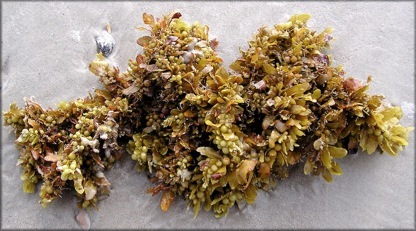
Sargassum: Edible but not the best of tastes.
The first is Desmarestia ligulata. It is laced with sulfuric acid but is used to make pickles. You can find it along the northwest coast of the United States. You’ll know it when you find it because it will burn your mouth. The other in North America (and Central America) is Cyanobacteria which is found in the Caribbean and linked to ciguarera poisoning. It’s not really a seaweed but is a blue-green algae found in the warmer waters. It is why one should never eat older barracuda. I should add never eat blue-green algae from fresh water either nor fish from a fresh water pond with a lot of blue-green algae. They are not on the menu. As for other parts of the world, there might be some toxic red seaweeds in the South Seas. Since most seaweed is edible, and nutritious, why isn’t it consumed more often? Taste and texture. I’ve collected Sargassum here in Florida and prepared it many ways. Semi-drying and frying isn’t too bad but Bladderwrack is better, Sea Lettuce better still. The latter makes very nice salads. Not surprisingly most land animals including birds don’t like seaweed. However, it does make good mulch and fertilizer. So while one may not use it directly in the diet it can still help sustain you with uses in the garden. During Victorian times it was highly used in English agriculture mostly as mulch and fertilizer. Here are some of my articles on seaweed: Bladderwrack, Caulpera, Codium, Gracilaria, Sargassum, Sea Lettuce, and Tape Seagrass.
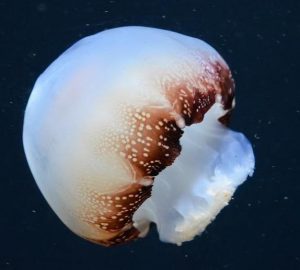
Stomolophus meleagris, one of our edible jellyfish.
While on the topic of the beach — I’m usually there this coming week for a Greek festival, a birthday, and Veterans Day — many jellyfish are edible, including some that are found in local waters. I had a friend from Taiwan who never ordered from the menu at Chinese restaurants. It was always off-the-menu and then after much discussion with the waiter and sometimes the chef. One of those chats produced a dish of jellyfish. I was hooked. It was very tasty and jellyfish can be caught while casting for other fish. (I like castnetting and am a castnet junkie.) While a substantial food I’m not sure jellyfish would qualify as a staple because catching them by hand is by chance (which does increase however when in season.) They are also mostly water and need to be dessicated immediately, not a small process. It all depends on how hungry you are and how many of them you have. You should get them live out of the water, not dead on the beach. To read about jellyfish go here
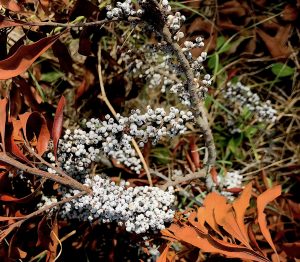
Southern Wax Myrtle berries. Photo by Green Deane
Just because you can do something doesn’t mean you should. Can you make a bayberry candle? Absolutely. Should you? If you have to, yes. If not you might want to reconsider. Southern Wax Myrtle berries are small. They have a little wax on them and why the species name is cerifera — wax producing. But it takes many gallons and a lot of hot work to get enough bayberry wax to mix with tallow (75/25) to make the famous smokeless candle that keeps away insects. No doubt hundreds of years ago it was worth it when folks had tallow from their own cattle, a lot of Bayberries and mosquitoes. Not so much today. But, you can use the dried berries as a spice and the leaves like bay leaves or to make a tea. To read more about the Southern Wax Myrtle go here.
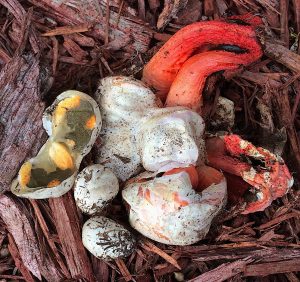
Stinkhorn Mushroom, Clathrus columnatus. Photo by Green Deane
There is a strange mushroom you can see this time of year that almost no one eats, the Column Stinkhorn. It smells like a dead animal, not exactly appetizing. The edibility of the Column Stinkhorn is also debatable. Most list it as not edible and there are reports of sickness in humans eating mature specimens. However, at least one noted expert says when in the egg stage they are mild and edible such as on the left side of the picture. It takes me years of studying a mushroom before I eat it. I think this one needs more study. Their fetid aroma attracts flies which then spread the spores around. Some plants also do that. Pawpaw comes to mind. There is another smelly Stinkhorn, Phallus ravenelli. It is definitely edible when in it’s egg stage. Tastes like radish.
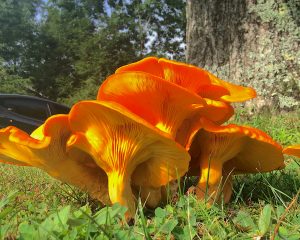
Toxic Jack O’Lanters. Photo by Green Deane
One attractive mushroom you should avoid are Jack O’Lanterns. They’re toxic and glow in the dark! A least one expert says “Jack O’ Lanterns” don’t glow in the dark but I took some home and they most certainly do. That is one of those irritation with plants. A recognized expert says one thing but your personal experience says something totally different. “Jacks” as they are called won’t kill you but they will make you very ill. I know someone who found that out personally… No, it was not me. I prefer to be non-sick. To that end I started and moderate five mushroom pages on Facebook: Southeastern US Mushroom Identification, Florida Mushroom Identification Forum, Edible Mushroom: Florida, Edible Wild Mushrooms and the Orlando Mushroom Group. They have some 25,000 members.

Green Deane videos are now available on a USB.
A 150-video USB or 135 video DVD set would be a good winter present and either is now $99. My nine-DVD set of 135 videos has been selling for seven years and are still available. They are the same videos I have on You Tube. Some people like to have a separate copy. A second option is a16-gig USB that has those 135 videos plus 15 more. While the videos can be run from the DVDs the videos on the USB have to be copied to your computer to play. They are MP4 files. The150-video USB is $99 and the 135-video DVD set is now $99. The DVDs will be sold until they run out then will be exclusively replaced by the USB. This is a change I’ve been trying to make for several years. So if you have been wanting the 135-video DVD set order it now as the price is reduced and the supply limited. Or you can order the USB. My headache is getting my WordPress Order page changed to reflect these changes. We’ve been working on it for several weeks. However, if you want to order now either the USB or the DVD set make a $99 “donation” using the link at the bottom of this page or here. That order form provides me with your address, the amount — $99 — tells me it is not a donation and in the note say if you want the DVD set or the USB.

Green Deane Forum
Want to identify a plant? Perhaps you’re looking for a foraging reference? You might have a UFO, an Unidentified Flowering Object, you want identified. On the Green Deane Forum we — including Green Deane and others from around the world — chat about foraging all year. And it’s not just about warm-weather plants or just North American flora. Many nations share common weeds so there’s a lot to talk. There’s also more than weeds. The reference section has information for foraging around the world. There are also articles on food preservation, and forgotten skills from making bows to fermenting food.
This is weekly newsletter #430, If you want to subscribe to this free newsletter you can find the sign-up form in the menu at the top of the page.
To donate to the Green Deane Newsletter click here.

